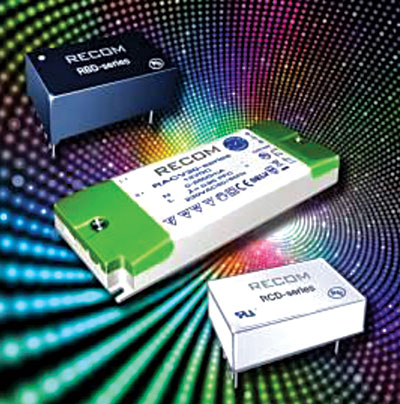Economic limit at 60V DC?
In principle, there are two ways in which the light output of a luminaire can be increased: by using more powerful LEDs and a higher current, or by installing more LEDs in the string, which in turn means that the voltage must be increased. Until recently, drivers reached their limit at 40V, so that it was not possible to include more than 11 or 12 LEDs in a string. Two-watt LEDs allowed for an efficacy corresponding to that of a 100W incandescent bulb. While multichip arrays are also generally operated with a voltage of around 40V, manufacturers are already considering significantly higher voltage levels. At 60V DC, the current SELV (safe extra low voltage) regulations are an obstacle with far-reaching commercial implications. Above this limit, additional technical measures need to be taken, which, of course, come at a price.

The high-voltage drivers available exploit the voltage to this limit and are able to supply up to 17 LEDs in series with constant currents between 350 and 1200mA. A powerful model comes in a metal casing and provides up to 70W. All drivers of this family can be dimmed in analogue and digital mode. The built-in reference source allows for dimming by means of a potentiometer, and also supplies external sensors or controllers for advanced control functions.
Flicker-free TRIAC dimming to zero
Many consumers are turning their back on energy-saving bulbs since they cannot be properly dimmed. They want the option of dimmed lighting to create the right atmosphere in a room. While dimming is practically impossible with energy-saving bulbs, some technical hurdles have to be crossed to make it possible with LEDs. With AC/DC drivers, the PFC circuit attempts to extract a near-sinusoidal current with the correct phasing from the mains by means of numerous current pulses. TRIAC dimmers, on the other hand, provide a phase-cut sine wave that deteriorates to current pulse if the device is dimmed too much. The two circuits interfere with each other.
Conventional dimmable drivers filter the input voltage by means of large electrolytic capacitors. This, however, makes it impossible to synchronise the timing between the PFC circuit in the driver and the TRIAC. As a result, the light flickers during dimming and continuous adjustment is not possible. There are, however, more problems. For safety reasons, there is always a low glimmer in incandescent bulbs, even when they are fully dimmed down. This is achieved by cutting the phase angle to a maximum of 45°. At this angle, an incandescent bulb is virtually off, while an LED luminaire remains lit to half its normal output. As there are many millions of TRIAC dimmers installed in homes and offices, and nobody wants to spend a lot of money replacing them when changing over to LED lighting, the industry had to come up with a solution.
Engineers have solved this problem by developing a driver that is tailor-made for installation in existing lighting control systems. With such a driver, it is now possible to dim LEDs continuously and without flickering to zero—offering consumers the comfort they enjoyed with incandescent bulbs. There is, however, one big difference: the colour of the dimmed light remains more or less constant, as there is no red shift typically associated with incandescent lamps.
To achieve this, additional circuits had to be developed. One such circuit is known as ‘dynamic PFC,’ ensuring that the width and number of switching pulses is matched to the leading-edge phase angle. This requires precise measurements, which can only be obtained with a second circuit. Dynamic PFC also ensures that the power factor remains above the prescribed threshold value during dimming.
Even if one is willing to accept the medium performance of low-cost drivers, one should always keep in mind the negative effect of large electrolytic capacitors on the lifetime of the driver. Over time, the electrolyte contained in the capacitor tends to dry up, especially if it is exposed to high temperatures, for example, near an LED heat sink.
If you wish to take full advantage of the typical service life of LEDs, you should avoid low-cost solutions. Similar to cars that are ready for the scrap heap the moment the engine fails, LED lamps only last as long as their drivers.
The author is vice president-marketing & sales, RECOM Lighting






